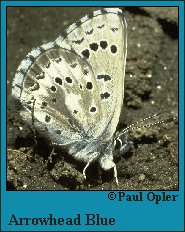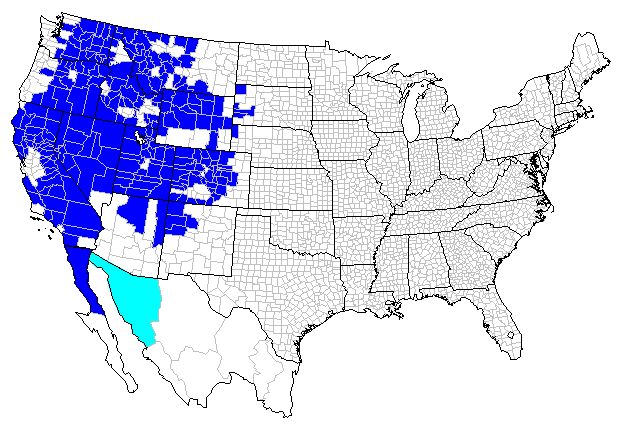 |
 

 |



Arrowhead Blue (Glaucopsyche piasus [Boisduval])
Wing span: 1 1/8 - 1 3/8 inches (2.9 - 3.5 cm).
Identification: Checkered fringes. Upperside of male violet blue with a wide border; female duller. Underside gray with many small black spots. Hindwing with postmedian band of white "arrowheads" pointing inward.
Life history: Males patrol during the day near host plants. Females lay eggs on flower buds of host plant; caterpillars eat flowers and fruits. Chrysalids hibernate.
Flight: One brood from March-July.
Caterpillar hosts: Lupine (Lupinus) and milkvetch (Astragalus) species in the pea family (Fabaceae).
Adult food: Flower nectar.
Habitat: Coastal dunes and lowlands in California; mountains elsewhere: scrub, openings in woods, roadsides, trails, meadows, clearings, streamsides.
Range: Local and uncommon. British Columbia and southern Alberta south through the mountains of western North America to southern California, northern Arizona, and western Nebraska.
Conservation: Populations in southern California need assessment; elsewhere populations are probably not in jeopardy.
The Nature Conservancy Global Rank: G5 - Demonstrably secure globally, though it may be quite rare in parts of its range, especially at the periphery.
Management needs: Not reported.
References:
Scott, J. A. 1986. The butterflies of North America. Stanford University Press,
Stanford, Calif. 583 pages, 64 color plates.
Tilden, J. W. 1986. A field guide to western butterflies. Houghton-Mifflin Co.,
Boston, Mass. 370 pages, 23 color plates.
Author: Jane M. Struttmann

